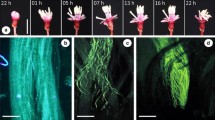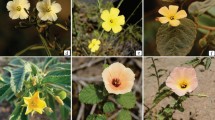Abstract
Stylar micromorphological diversity of 42 Asteraceae species from Argentina was analysed considering species phylogenetic membership and some floral reproductive functions (pollen presentation and pollen reception). In particular, the morphology and organisation of pollen presenter (sweeping hairs) and pollen receptive structures (stigmatic papillae) were described. Results showed that style morphology of the studied species is far more diverse than the categories previously established for Asteraceae, and that it is problematic to relate the sweeping-hair arrangement of species to the only three modes of pollen presentation described for the family, indicating that the hypothesised relationship could be more complex than was formerly thought. For all species with di- or trimorphic florets, the styles of female florets were more slender and without or with more reduced sweeping hairs than the styles of hermaphrodite florets, and divergences of sweeping hair arrangements and morphology were higher among phylogenetically related species. These results suggest that functional aspects of floral morphology seem to be more important than phylogenetic constraints as selective forces determining stylar pollen presentation structures. In contrast, stigmatic-area organisation as well as the morphology of stigmatic papillae remain identical between female and hermaphrodite florets and among phylogenetically related species. Thus, stigmatic papilla morphology seems to be a phylogenetically constrained character in the studied species.




Similar content being viewed by others
References
Baldwin BG, Wessa BL, Panero JL (2002) Nuclear rDNA evidence for major lineages of helenioid Heliantheae (Compositae). Syst Bot 27:161–198
Bremer K (1987) Tribal interrelationships of the Asteraceae. Cladistics 3:210–253
Bremer K (1994) Asteraceae: cladistics and classification. Timber Press, Oregon
Bremer K (1996) Major clades and grades of the Asteraceae. In: Hind DJN, Beentje HJ (eds) Compositae: systematics. Proceedings of the international compositae conference, Kew, 1994, vol 1, Royal Botanical Gardens, Kew, pp 1–7
Erbar C, Leins P (1995) Portioned pollen release and the syndromes of secondary pollen presentation in the Campanulales–Asterales-complex. Flora 190:323–338
Erbar C, Leins P (2000) Some interesting features in the capitulum and flower of Arnaldoa macbrideana Ferreyra (Asteraceae, Barnadesioideae). Bot Jahrb Syst 122:517–537
Funk VA, Bayer RJ, Keeley S, Chan R, Watson L, Gemeinholzer B, Schilling E, Panero JL, Baldwin BG, Garcia-Jacas N, Susanna A, Jansen RK (2005) Everywhere but Antarctica: using a supertree to understand the diversity and distribution of the Compositae. Biol Skr 55:343–374
Howell GJ, Slater AT, Knox RB (1993) Secondary pollen presentation in Angiosperms and its biological significance. Aust J Bot 41:417–438
Ladd PG (1994) Pollen presenters in the flowering plants-form and function. Bot J Linn Soc 115:165–195
Leins P, Erbar C (1990) On the mechanisms of secondary pollen presentation in the Campanulales–Asterales-complex. Botanica Acta 103:87–92
Panero JL, Funk VA (2002) Toward a phylogenetic subfamilial classification for the Compositae (Asteraceae). Proc Biol Soc Wash 115:909–922
Small J (1915) The pollen-presentation mechanism in the Compositae. Ann Bot 29:457–470
Yeo PF (1993) Secondary pollen presentation. Form, function and evolution. Pl Syst Evol Supp 6, Wien, New York
Acknowledgments
We thank Peter Leins, Claudia Erbar and Ramiro Aguilar for useful comments on early versions of this manuscript, and Gerardo Robledo, Ana María González and Ricardo Munch for technical support in SEM micrographs. The study was supported by “Consejo Nacional de Investigaciones Científicas y Técnicas”(CONICET), “Agencia Nacional de Promoción Científica y Tecnológica”, “Secretaría de Ciencia y Tecnología de la Universidad Nacional de Córdoba”, and “Agencia Córdoba Ciencia”. Thanks are due to “Consejo de Investigaciones Científicas y Técnicas de la Provincia de Córdoba” and the “Academia Nacional de Ciencias Exactas, Físicas y Naturales” for the fellowships to the first author. C.T. and L.G. are members of CONICET.
Author information
Authors and Affiliations
Corresponding author
Electronic supplementary material
Below is the link to the electronic supplementary material.
10265_2007_81_MOESM1_ESM.rtf
S1. Style morphological characters of 42 Asteraceae species. Values show means ± SD. * = only the female floret has been measured; nd = no data. Species were arranged according to the phylogenetic classification proposed by Funk et al. (2005), following an ascending evolutionary position. (RTF 132 kb)
Rights and permissions
About this article
Cite this article
Torres, C., Galetto, L. Style morphological diversity of some Asteraceae species from Argentina: systematic and functional implications. J Plant Res 120, 359–364 (2007). https://doi.org/10.1007/s10265-007-0081-4
Received:
Accepted:
Published:
Issue Date:
DOI: https://doi.org/10.1007/s10265-007-0081-4




